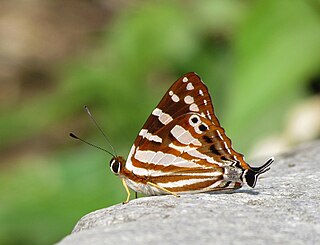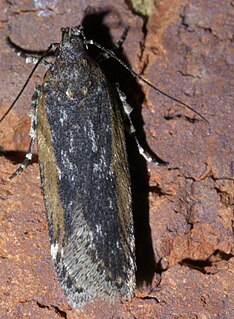
Apamea crenata, known as the clouded-bordered brindle, is a moth in the family Noctuidae. It is distributed throughout the Palearctic realm. In the North it crosses the Arctic Circle, in the Mediterranean it is found only in cool locations and mountains avoiding very hot areas. In the Alps, it rises to an altitude of about 2000 metres.

Parnassius hardwickii, the common blue Apollo, is a high-altitude butterfly which is found in South Asia. It is a member of the snow Apollo genus (Parnassius) of the swallowtail family (Papilionidae). This butterfly is found from the Chitral District to Sikkim and is found from 6,000 to 17,000 feet, making it one of the most commonly encountered species of Apollo in the Indian subcontinent.

Dodona egeon, the orange Punch, is a small but striking butterfly found in the Indomalayan realm - in Mussoorie to Assam, Burma (nominate) and Peninsular Malaya that belongs to the family Riodinidae.

Miletus symethus, the great brownie, is a small butterfly found in India that belongs to the lycaenids or blues family. The species was first described by Pieter Cramer in 1777.

Curetis bulis, the bright sunbeam, is a species of butterfly belonging to the lycaenid family. It is found in Asia.
Hellinsia iobates is a moth of the family Pterophoridae that is found in the U.S. state of Arizona. The species was first described by William Barnes and Arthur Ward Lindsey in 1921.

Filatima pseudacaciella, the dusky-backed filatima moth, is a moth of the family Gelechiidae. It is found in North America, where it has been recorded from California, Illinois, Indiana, Kansas, Kentucky, Louisiana, Maine, Massachusetts, Mississippi, New Hampshire, New York, Ohio, Oklahoma, Ontario, Tennessee and West Virginia.
Gelechia badiomaculella is a moth of the family Gelechiidae. It is found in North America, where it has been recorded from Kentucky.
Gelechia maculatusella is a moth of the family Gelechiidae. It is found in North America, where it has been recorded from California.
Gelechia ocherfuscella is a moth of the family Gelechiidae. It is found in North America, where it has been recorded from California.
Pseudochelaria walsinghami is a moth of the family Gelechiidae. It was described by Dietz in 1900. It is found in North America, where it has been recorded from Alabama, Arizona, Arkansas, Florida, Illinois, Indiana, Kansas, Kentucky, Maine, Mississippi, Nebraska, North Carolina, Ohio, Pennsylvania, South Carolina and Tennessee.
Gelechia ribesella is a moth of the family Gelechiidae. It was described by Vactor Tousey Chambers in 1875. It is found in North America, where it has been recorded from Mexico, California, Colorado, Oregon and British Columbia.
Gelechia packardella is a moth of the family Gelechiidae. It was described by Vactor Tousey Chambers in 1877. It is found in North America, where it has been recorded from Colorado.

Tricyanaula metallica is a moth of the family Gelechiidae. It was described by Walsingham in 1891. It is found in South Africa and Gambia.

Aristotelia rubidella is a moth of the family Gelechiidae. It was described by James Brackenridge Clemens in 1860. It is found in North America, where it has been recorded from Alabama, Alberta, Arkansas, British Columbia, California, Florida, Georgia, Illinois, Indiana, Iowa, Kentucky, Louisiana, Maine, Manitoba, Maryland, Massachusetts, Michigan, Mississippi, New Jersey, North Carolina, Ohio, Oklahoma, Ontario, Quebec, South Carolina, Tennessee, Texas, Virginia, Washington, West Virginia and Wisconsin.
Idiopteryx obliquella is a moth in the family Lecithoceridae. It was described by Walsingham in 1881. It is known from South Africa.
Gonionota dissita is a moth in the family Depressariidae. It was described by Clarke in 1964. It is found in Trinidad.
Gonionota excavata is a moth in the family Depressariidae. It was described by Clarke in 1964. It is found in Mexico.
Cerconota dimorpha is a moth in the family Depressariidae. It was described by W. Donald Duckworth in 1962. It is found in Ecuador.
Chlamydastis squamosa is a moth in the family Depressariidae. It was described by Lord Walsingham in 1892 and is found in the West Indies.







